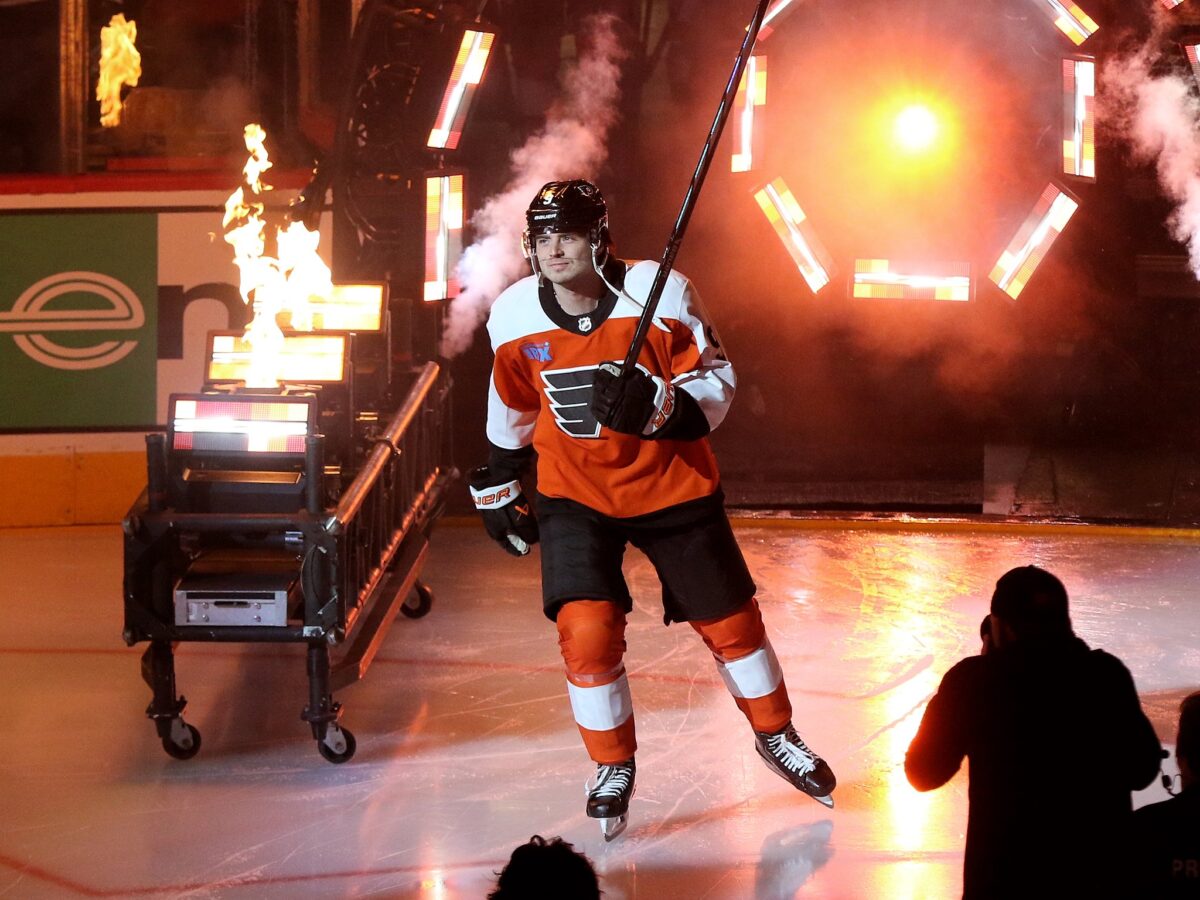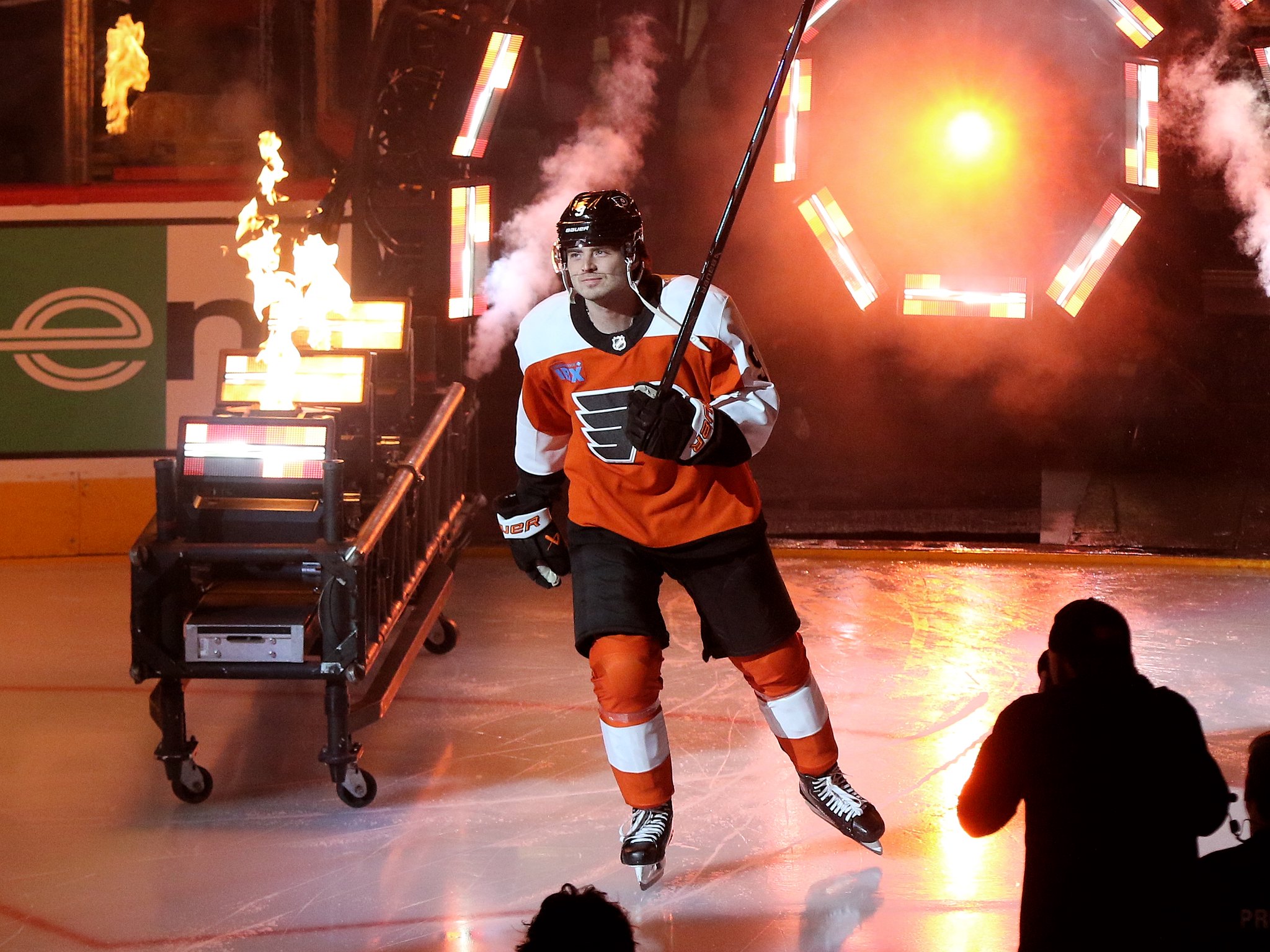The once-rebuilding Philadelphia Flyers are entering a season of change: new coaches, new players, and a new direction. In a 2025–26 campaign of uncertainty (but in a good way), let’s take a look at and break down three hot takes.
Hot Take 1: Zegras Has an 80-Point Season
Over his past two campaigns, Trevor Zegras has only accumulated 47 points across 88 games. But he’s also entering a best-case scenario: likely to switch back to center full-time, and be a top-line one at that. If he regularly plays alongside Matvei Michkov in this upcoming season, I think he can reach a career-high 80 points.
For further context, no Flyer has reached the 80-point threshold since 2018–19. So, the prospects of this happening are slim, at least on paper. But there’s a catch. While Zegras’ recent showings have not been encouraging in the scoring department, he’s very much the same player that donned the cover of EA SPORTS NHL 23—none of the traits went away. If he has Michkov by his side, they can be maximized.
Related: 3 Reasons Flyers’ Matvei Michkov Will Be NHL’s Top Breakout Star in 2025-26
Firstly, Zegras quietly has a very disruptive stick. Throughout his career, he has made plays like the one shown below: stripping the puck off of an unsuspecting attacker, leading to a chance the other way (a goal, in this instance). With Michkov, who is already an expert in timing breakaways, plays like this can become a secret weapon in 2025–26. Be prepared for that.
Mason McTavish snipes on the breakaway to extend the Ducks lead to 3-1 🎯 pic.twitter.com/Dhdn19BKX3
— Sportsnet (@Sportsnet) April 8, 2025
Next, I want to discuss how demoralizing Zegras’ skill set can be in 1-on-1 situations. If there’s a single defender covering him on a rush, he can and will expose them—that’s part of the reason why his name is so recognizable. Consistently carrying the puck up the ice to dangle opponents out of their skates, he’s a human highlight reel. That much also hasn’t changed.
Finally, his creativity is off the charts. Zegras finds ways to make things happen, even during sequences most would consider dead. He’s a master of creating advantages for his linemates while simultaneously refraining from forcing anything that isn’t there, or could lead to trouble the other way.
All three of these traits have one thing in common: they make Michkov’s job easier. Zegras can add another dynamic element to the 20-year-old’s game, which will benefit them mutually. I’ve spoken on it before, but this is a duo I am very high on. If they work together, both of them can reach the 80-point mark.
Hot Take 2: Flyers’ Goaltending Will Improve Substantially
In 2024–25, the Flyers finally ended their three-season streak of holding the NHL’s least efficient power play (by finishing third-last, admittedly). But unfortunately, they have a new dragon to slay: they’ve ranked 32nd in team save percentage back-to-back.
The good news is that there’ll be a rookie-free tandem between the pipes. Giving veteran backup Dan Vladař a two-year deal, he’ll likely be splitting starts with Samuel Ersson this upcoming season. Even still, on paper, this is only a marginal upgrade over what the Flyers had in their previous two campaigns—”improve substantially” is quite the claim. So, let’s break it down.
As far as backups go, Vladař is a statistically average one. Among goaltenders who played between 20 and 35 games last season, he ranked in the 64th and 44th percentiles for save percentage and goals saved above expected, respectively. That may seem insignificant, but Ivan Fedotov found himself in the 12th and 4th percentiles for that list.
Personally, I believe that at least some of the Flyers’ struggles between the pipes had to do with coaching. With that unit overhauled and a fairly notable backup goalie upgrade, there should be more optimism than there is presently. Instead of two rookies—Fedotov and Aleksei Kolosov—having Ersson’s back, it’s a proven option who has put up standard numbers for his role.
Give or take, the Flyers should be getting average backup play—a huge upgrade on the dreadful numbers they’ve seen. Another worry here is that Ersson hasn’t done particularly well as a starter, with a .887 save percentage over the past two seasons. But this is where the brand-new coaching staff may come in handy. Though it’s more of a wait-and-see type of thing, I am actually somewhat hopeful regarding netminding. I think a 20th-place finish is attainable.
Hot Take 3: Drysdale Shows Top-Pairing Upside
Early in his Flyers tenure, it was a battle for Jamie Drysdale. Outscored 32–10 with a team-worst 42.65% expected goal share at 5-on-5 play between his debut and a month-long injury suffered in November, his direction was troublesome. There wasn’t much reason for excitement.
Everything changed upon Drysdale’s return from injury, and it was evident immediately. Though he was far from perfect, he started to show some promising signs in his final 55 games of last season.

Now, Drysdale still had the same defensive woes, allowing 3.62 goals per 60 minutes at five-a-side hockey—one of the NHL’s worst marks. Even if a disastrous .869 on-ice save percentage was the main culprit, defense remains a work in progress.
But he took a big step in the puck-moving department. It was noticeable on the ice, and the numbers back it up: 3.04 goals scored per 60 minutes and a 54.35% expected goal share at 5-on-5. Drysdale was consistently retrieving pucks and starting breakouts the other way.
This was accomplished in second-pairing minutes, with by far the best results coming next to Nick Seeler (57.45% goal share). Keeping the two together may be in each other’s best interest, and could complicate the “top-pairing upside” claim, but Drysdale’s still 23 years old. While he has yet to establish himself as a true No. 3–4 defender, his talent translated into some positive results last season. I think he can take an even larger step in 2025–26.
As mentioned, Drysdale’s puck-moving game is already a strength. If he can further improve on his puck-carrying game, defending the rush with his elite speed, and contributing in offensive zone sequences, then he may have what it takes to man the Flyers’ top pairing for many seasons to come. He’s shown flashes in all of these areas before.
Do you agree with these hot takes, or have any of your own? Feel free to share your thoughts below!
Stats courtesy of Evolving-Hockey and Natural Stat Trick




